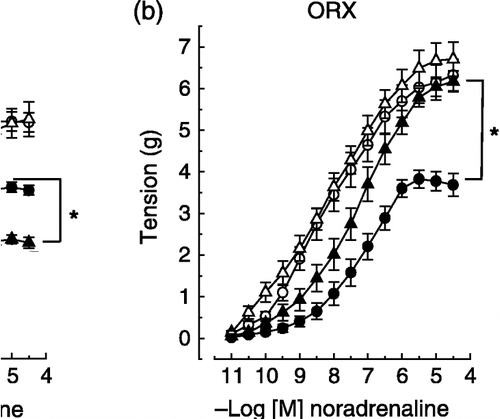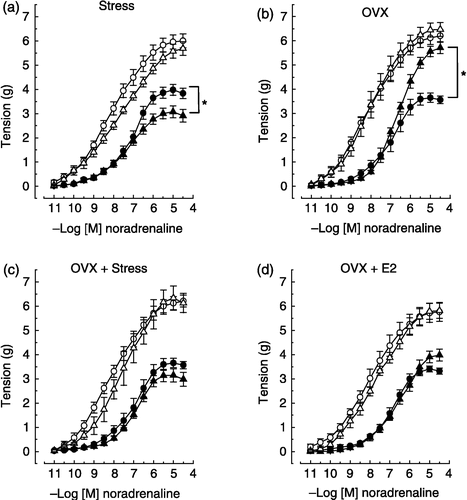Figures & data
Table I. Effects of gonadectomy and gonadal hormonal replacement on rat body, uterus, vas deferens, seminal vesicle and aorta weights.
Figure 1 Effects of noradrenaline on two rings, one with and the other without endothelium, of the same thoracic aorta isolated from control and experimental male rats. The experimental protocols were: (a) stress (2 h-immobilization), (b) orchiectomy ORX, (c) (ORX) plus stress, (d) ORX plus testosterone (test), and (e) ORX plus test plus stress. The removal of endothelium increased maximum response to noradrenaline (P < 0.05), except in orchiectomized non-stressed males (panel b). None of the experimental protocols altered the vascular smooth muscle reactivity to noradrenaline vs. respective controls (see denuded aorta responses, P>0.05). Stress decreased and ORX increased the intact aorta maximum response to noradrenaline (panels a and b, respectively). ORX did not prevent the decrease in the intact aorta reactivity to noradrenaline induced by stress (panels c × b). The maximum response to noradrenaline in intact aorta from stress-exposed orchiectomized rats (panel c, filled triangle) was significantly different from non-stressed intact males (panel c, filled circle). Testosterone treatment restored the intact aorta reactivity to noradrenaline in orchiectomized non-stressed males (panels d × b) and also recovered the stress response in aorta from orchiectomized rats (see panels e, c and a). Values are means ± SEM. *P < 0.05 vs. respective controls. Animal number range = 6–12 per group.

Figure 2 Effects of noradrenaline on two rings, one with and the other without endothelium, of the same thoracic aorta isolated from control and experimental female rats. The experimental protocols were: (a) stress (2 h-immobilization), (b) ovariectomy (OVX), (c) OVX plus stress, (d) OVX plus 17β-estradiol (E2), and (e) OVX plus E2 plus stress. The removal of endothelium increased maximum response to noradrenaline (P < 0.05), except in ovariectomized non-stressed females (panel b). None of the experimental protocols altered the vascular smooth muscle reactivity to noradrenaline vs. respective controls (see denuded aorta responses, P>0.05). Stress decreased and OVX increased maximum response to noradrenaline in the intact aorta (panels a and b, respectively). OVX did not prevent the decrease in the intact aorta reactivity to noradrenaline induced by stress (panels c × b). The maximum response to noradrenaline in the intact aorta from stress-exposed ovariectomized rats (panel c, filled triangle) was not significantly different from non-stressed intact females (panel c, filled circle). 17β-estradiol treatment restored the intact aorta reactivity to noradrenaline in ovariectomized non-stressed females (panels d × b) and recovered the stress response in aorta from ovariectomized rats (see panels e, c and a). Values are means ± SEM. *P < 0.05 vs. respective controls. Animal number range = 6–14 per group.

Table II. Effects of gonadectomy and gonadal hormonal replacement on the EC50 values for noradrenaline obtained for two rings, one with and the other without endothelium, of the same thoracic aorta from male and female rats, submitted or not to stress.
Table III. Maximal responses and EC50 values to noradrenaline obtained in two rings, one with and the other without endothelium, of the same thoracic aorta from intact male and female rats, submitted or not to stress, in the presence of l-NAME or indomethacin.